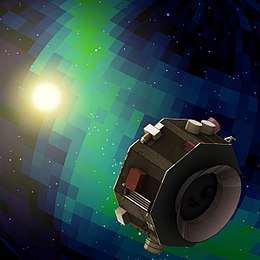Interstellar Mapping and Acceleration Probe
 | |
| Mission type | Heliosphere research |
|---|---|
| Operator | NASA |
| Start of mission | |
| Launch date | 2024 |
| Orbital parameters | |
| Reference system | Sun–Earth L1 |
| Regime | Halo orbit |
|
Solar Terrestrial Probes | |
IMAP (Interstellar Mapping and Acceleration Probe) is a heliosphere observation mission. It will help researchers better understand the boundary of the heliosphere, a sort of magnetic bubble surrounding and protecting our solar system. [1]
It is the fifth mission in the Solar Terrestrial Probes program, after TIMED, Hinode, STEREO and MMS.[1]
Science
The heliosphere boundary is where the constant flow of particles from our Sun, called the solar wind, collides with material from the rest of the galaxy. This collision limits the amount of harmful cosmic radiation entering the heliosphere. IMAP will collect and analyze particles that make it through.
Another objective of the mission is to learn more about the generation of cosmic rays in the heliosphere. Cosmic rays created locally and from the galaxy and beyond affect human explorers in space and can harm technological systems, and likely play a role in the presence of life itself in the universe.
Destination
The spacecraft will be positioned about one million miles (1.5 million kilometers) away from Earth towards the Sun at what is called the first Lagrange point L1. This will allow the probe to maximize use of its instruments to monitor the interactions between solar wind and the interstellar medium in the outer solar system.
Mission management
This is the fifth mission in NASA’s Solar Terrestrial Probes (STP) Program portfolio.[2] The Heliophysics Program Office at NASA’s Goddard Space Flight Center in Greenbelt, Maryland, manages the STP Program for the agency’s Heliophysics Division in Washington.
The mission’s principal investigator is David J. McComas of Princeton University. The Johns Hopkins University’s Applied Physics Laboratory in Laurel, Maryland, will provide project management. The mission will carry 10 science instruments provided by international and domestic research organizations and universities.
The mission is cost-capped at US$492 million, excluding cost for the launch vehicle. NASA's Launch Services Program (LSP) will select and manage the launch service.
TechDemo opportunity
NASA’s Science Mission Directorate (SMD) intends to release a Third Stand Alone Missions of Opportunity Notice (SALMON-3) Program Element Appendix (PEA) for the 2018 Heliophysics Technology Demonstration (TechDemo) Mission of Opportunity (MO).[3] TechDemo investigations will launch on the Interstellar Mapping and Acceleration Probe (IMAP). The payloads are designated as Class D as defined in NPR 8705.4.
TechDemo investigations must be proposed for flight as a secondary payload with the IMAP mission. Up to two ports on a Secondary Payload Adapter (ESPA) will be provided to accommodate this investigation. The ESPA is intended to be an unpowered, non-propulsive, ESPA Grande ring. The TechDemo SCM(s) will be released from the ESPA and/or the IMAP launch vehicle after IMAP injection into a transfer orbit to the Earth-Sun L1 Lagrangian point.
Down-selection is targeted for Third Quarter FY 2020.
References
- 1 2 "NASA Selects Mission to Study Solar Wind Boundary of Outer Solar System". NASA. June 1, 2018. Retrieved 5 June 2018.
- ↑ "Solar Terrestrial Probes". NASA Science (beta). NASA. Retrieved 5 June 2018.
- ↑ "Community Announcement NNH18ZDA008L: 2018 Heliophysics Technology Demonstration Mission of Opportunity via SALMON-3". NASA. April 26, 2018. Retrieved 5 June 2018.
attribution: public domain content from https://www.nasa.gov/press-release/nasa-selects-mission-to-study-solar-wind-boundary-of-outer-solar-system